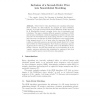Free Online Productivity Tools
i2Speak
i2Symbol
i2OCR
iTex2Img
iWeb2Print
iWeb2Shot
i2Type
iPdf2Split
iPdf2Merge
i2Bopomofo
i2Arabic
i2Style
i2Image
i2PDF
iLatex2Rtf
Sci2ools
PSIVT
2009
Springer
2009
Springer
Inclusion of a Second-Order Prior into Semi-Global Matching
Today’s stereo vision algorithms and computing technology allow real-time 3D data analysis, for example for driver assistance systems. A recently developed Semi-Global Matching (SGM) approach by H. Hirschm¨uller became a popular choice due to performance and robustness. This paper evaluates different parameter settings for SGM, and its main contribution consists in suggesting to include a second order prior into the smoothness term of the energy function. It also proposes and tests a new cost function for SGM. Furthermore, some preprocessing (edge images) proved to be of great value for improving SGM stereo results on real-world sequences, as previously already shown by S. Guan and R. Klette for belief propagation. There is also a performance gain for engineered stereo data (e.g.) as currently used on the Middlebury stereo website. However, the fact that results are not as impressive as on the .enpeda.. sequences indicates that optimizing for engineered data does not neccessarily i...
| Added | 26 Jul 2010 |
| Updated | 26 Jul 2010 |
| Type | Conference |
| Year | 2009 |
| Where | PSIVT |
| Authors | Simon Hermann, Reinhard Klette, Eduardo Destefanis |
Comments (0)

